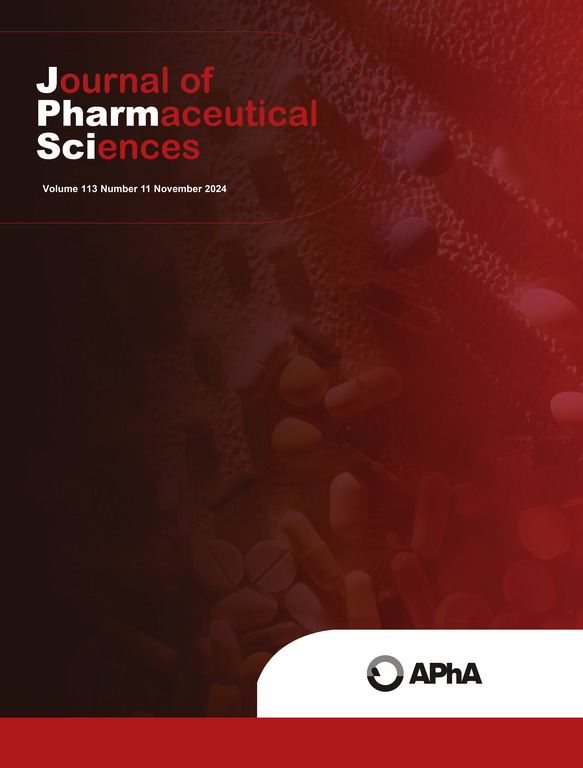Development of a thermal stabilizer formulation optimized by response surface methodology for Senecavirus A antigen
IF 3.7
3区 医学
Q2 CHEMISTRY, MEDICINAL
引用次数: 0
Abstract
Numerous members of the family Picornaviridae, such as the Senecavirus A (SVA) and foot-and-mouth disease virus (FMDV), exhibit thermal instability, resulting in the dissociation of viral particles, which affects the insufficient potency of the vaccine. Based on this characteristic, this study aimed to maintain the thermal stability of SVA by supplementing it with a stabilizer. Excipients, such as sucrose, mannitol, sorbitol, polyethylene glycol (PEG), L-arginine (L-Arg), glutamic acid (Glu), polyvinyl pyrrolidone (PVP), bovine serum albumin (BSA), and potassium chloride (KCl) dissolved in Tris-HCl buffer solution, retained the infectivity of SVA in the thermostability assay. Thermal stability formulations were developed by combining different excipients in disaccharide polyol systems and optimizing formulations using the Box-Behnken experimental design (BBD) combined with response surface methodology (RSM). Three significant factors were studied: sucrose 9.9%, sorbitol 9.9%, and L-Arg 0.06 mol/L against virus titer of thermal-resistance of SVA as a response. The formulation improved the stability of SVA, whose viral infectivity titer decreased by 101.0 TCID50/mL at 4°C, 25°C, and 37°C, respectively, until it decreased by 101.21 TCID50/mL at 7 d of incubation at 42°C. The combinational thermal stabilizer generated in this study enabled the stabilization of the SVA, which might contribute to storage and transportation when the cold chain is unavailable, especially in rural areas. Therefore, the thermal stabilizer is an efficient candidate stabilizer for picornavirus formulations, which keep picornavirus infectivity at various temperatures. Further optimization of this approach will provide new opportunities for the generation of stabilizer formulation from different stabilizers.
用响应面法优化塞内卡病毒a抗原热稳定剂配方的研制。
小核糖核酸病毒科的许多成员,如塞内卡病毒A (SVA)和口蹄疫病毒(FMDV),表现出热不稳定性,导致病毒颗粒解离,从而影响疫苗效力不足。基于这一特点,本研究旨在通过添加稳定剂来保持SVA的热稳定性。辅料,如蔗糖、甘露醇、山梨醇、聚乙二醇(PEG)、l -精氨酸(L-Arg)、谷氨酸(Glu)、聚乙烯吡罗烷酮(PVP)、牛血清白蛋白(BSA)和氯化钾(KCl)溶解在tri - hcl缓冲液中,在热稳定性试验中保留了SVA的感染性。采用Box-Behnken实验设计(BBD)结合响应面法(RSM)优化了双糖多元醇体系中不同赋形剂的热稳定性配方。研究了蔗糖9.9%、山梨醇9.9%、L-精氨酸0.06 mol/L三个显著因子对SVA抗热病毒滴度的影响。该制剂提高了SVA的稳定性,在4℃、25℃、37℃条件下,SVA的病毒感染滴度分别下降1.0 TCID50/mL,在42℃条件下,培养7 d时,SVA的病毒感染滴度下降1.21 TCID50/mL。本研究中产生的组合热稳定剂能够稳定SVA,这可能有助于在冷链不可用时的储存和运输,特别是在农村地区。因此,热稳定剂是小核糖核酸病毒制剂中一种有效的候选稳定剂,可在不同温度下保持小核糖核酸病毒的传染性。该方法的进一步优化将为从不同的稳定剂生成稳定剂配方提供新的机会。
本文章由计算机程序翻译,如有差异,请以英文原文为准。
求助全文
约1分钟内获得全文
求助全文
来源期刊
CiteScore
7.30
自引率
13.20%
发文量
367
审稿时长
33 days
期刊介绍:
The Journal of Pharmaceutical Sciences will publish original research papers, original research notes, invited topical reviews (including Minireviews), and editorial commentary and news. The area of focus shall be concepts in basic pharmaceutical science and such topics as chemical processing of pharmaceuticals, including crystallization, lyophilization, chemical stability of drugs, pharmacokinetics, biopharmaceutics, pharmacodynamics, pro-drug developments, metabolic disposition of bioactive agents, dosage form design, protein-peptide chemistry and biotechnology specifically as these relate to pharmaceutical technology, and targeted drug delivery.

 求助内容:
求助内容: 应助结果提醒方式:
应助结果提醒方式:


